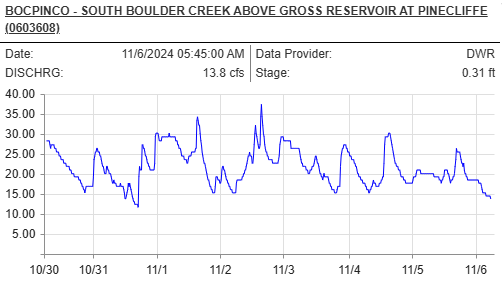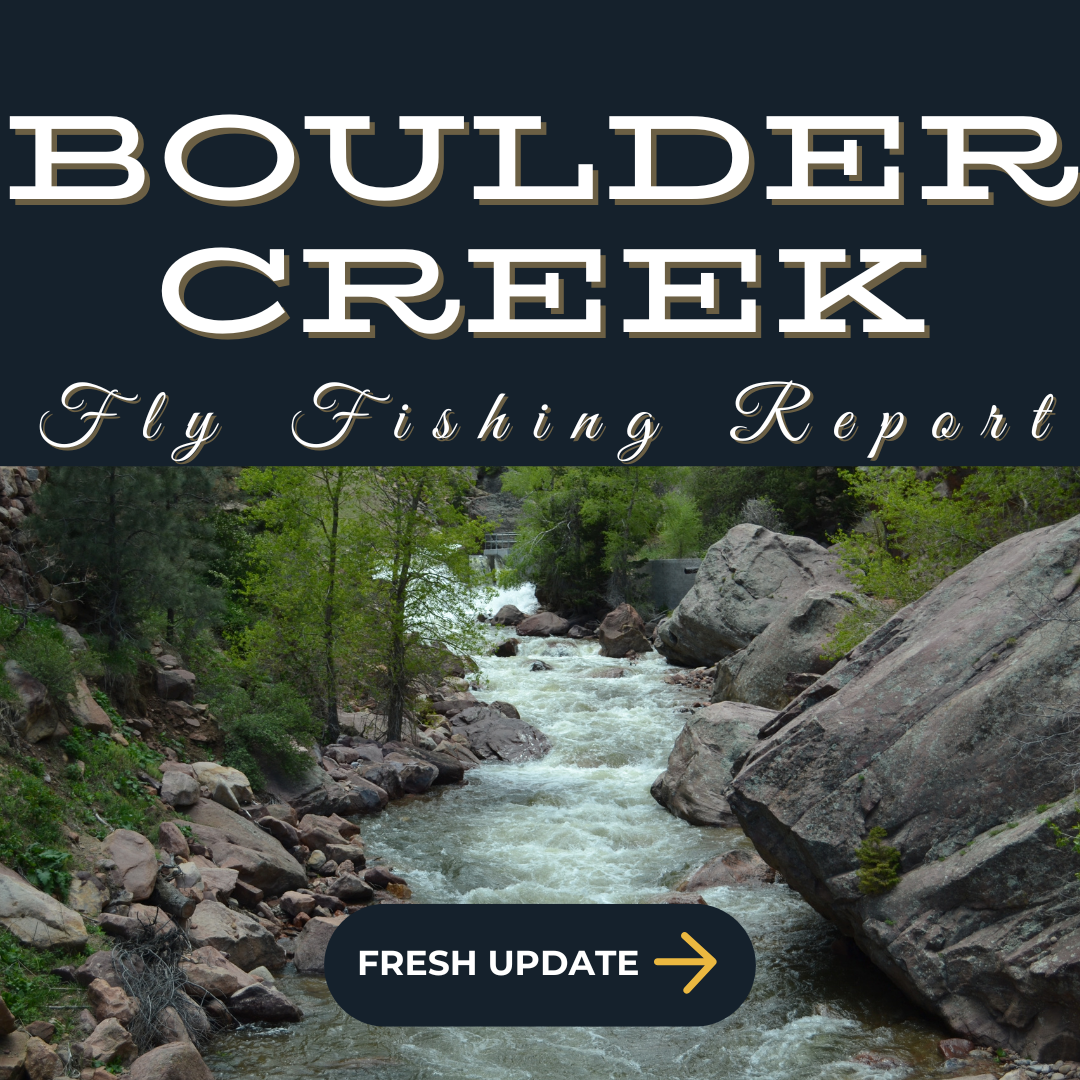Boulder Creek is a compact, fast-reading Front Range stream that rewards anglers who fish efficiently in winter. Cold, clear water pushes trout tight to structure, and success depends on short drifts, quick adjustments, and knowing when to move. This is classic Boulder Creek winter fly fishing: technical pocket water, minimal margin for error, and honest feedback.

Updated: 12/31/25
The Boulder Creek corridor from Boulder Canyon through town is settled into a stable winter pattern. Flows are low for the season, clarity is high, and trout are holding in plunge pools, pocket tails, and slow seams behind boulders. Feeding windows are short but predictable when sunlight reaches the canyon floor and urban stretches alike.
This week’s Boulder Creek fly fishing report emphasizes coverage and precision. Midges dominate the food supply, with occasional baetis nymphs active during mild afternoons. Boulder Creek does not reward camping one run. Read the water, fish the best pockets, and move on.
Listen to the Audio Overview
Conditions Summary
%20(5).png?width=800&height=175&name=Guide%20Rating%20(800%20x%20175%20px)%20(5).png)
Flow: Low winter baseflow
Water Temperature: Low to mid 30s
Air Temperature: High 30s to low 40s during the day
Clarity: Clear
Crowds: Light in winter, moderate near town on weekends
Best Window: 11 a.m. to 2:30 p.m.
Fishing Type Focus: Winter pocket-water nymphing with short controlled drifts
Weather
Boulder Colorado Weather
Cold mornings give way to brief midday warmth when the sun reaches the canyon floor. Calm days offer the best fishing. Wind and cloud cover shorten feeding windows and make already technical pocket water harder to manage.
Top Flies in Your Box This Week
- Black Beauty 20 to 24
- Zebra Midge (black or red) 20 to 22
- Mercury Midge 20 to 22
- RS2 (black or gray) 20 to 22
- WD-40 20 to 22
- Small Pheasant Tail 18 to 20
- Juju Baetis 20 to 22
- Mini Leech (black) 12 to 14
Pro Rig of the Week: Boulder Creek Short-Pocket Rig
- Indicator: Small yarn or minimal pinch-on indicator
- Lead Fly: Small Pheasant Tail 18 to 20
- Dropper: Black Beauty or Zebra Midge 20 to 22
- Weight: One small split shot placed close to the flies
- Target Water: Plunge pools, pocket tails, and short soft seams
Hatch Chart for December
| Bug Type | Size | Notes |
|---|---|---|
| Midges | 20 to 26 | Primary winter food source |
| Baetis nymphs | 20 to 22 | Occasional activity on mild afternoons |
Access Points
Eben G. Fine Park
Town section with deeper winter water and soft edges perfect for tiny midges.
⭐ 4.6
Boulder Canyon Pullouts (near Realization Point area)
Classic canyon pocket water; extremely clear and technical in winter.
⭐ 4.5
Fourmile Canyon Confluence
Offers mixing flows and slightly deeper structure.
⭐ 4.4
KOA / East of 28th Street
Wider river and slower winter water; better for beginners.
⭐ 4.3
Betasso Access Corridor
Cold and slow but stable winter holding water in deeper pockets.
⭐ 4.3
Local Regulations & Notes
- Winter flows are extremely low; avoid spooking fish with heavy wading
- Watch for ice shelves along shaded bends
- Downtown sections see higher foot traffic; fish early or midday
- Be cautious of spawning redds in shallow gravel
- Barbless hooks strongly recommended
FAQ
Is Boulder Creek Good for Fly Fishing in Winter?
Yes. Boulder Creek offers consistent winter trout fishing close to Boulder, especially for anglers comfortable fishing pocket water and moving often.
How Does Boulder Creek Compare to Clear Creek?
Boulder Creek is slightly larger and more forgiving, while Clear Creek is tighter and more technical. Both reward short drifts and efficient movement in winter.
Q: Is Boulder Creek worth fishing in December?
A: Yes, especially the deeper town sections, but it’s a very technical small-stream winter fishery.
Q: Can I fish dries?
A: Only on the warmest afternoons when midge clusters appear.
Q: What section fishes best in winter?
A: Town stretches from Eben G. Fine to 28th Street.
Q: What tippet should I use?
A: 6X is mandatory for tiny midges in clear water.
Q: Is the canyon better than town?
A: The canyon is colder and more technical; fish town for more consistent winter action.
Q: What time should I fish?
A: Midday when temperatures rise a few degrees.
Companion Article for December
Stop Here After the River
Avery Brewing Co. – Gunbarrel
Not the busiest brewery in Boulder, but one of the most consistently excellent. Spacious taproom, warm seating, and perfect after-fish energy.
What to order: White Rascal or the Ellie’s Brown Ale. Pair it with the green chile queso fries for the full winter-warmup treatment.
.png?width=300&height=100&name=Copy%20of%20Rise%20Beyond%20Logo%2012.31.24%20(300%20x%20100%20px).png)
.png)
-1.png)

